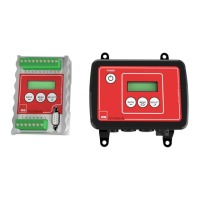AQ Elteknik AB Ultrasound Controller Manual 29
In an ex-installation, shielding aluminum plates
must be placed outside each group of zener
barriers belonging to each Ultrasound Controller.
order number: Ex-barriershield, see Level Switch
Ex manual.
Measuring Gel
Gel media used in chromatography systems
consists of small particles which scatters the
ultrasound causing attenuation. Ultrasound
attenuation is a reliable method to measure gel
concentration. For attenuation <60dB/m,
ultrasound attenuation per meter is fairly
proportional to gel concentration. The amount
depends on ultrasound frequency and gel type.
The actual measured attenuation is also
proportional to echo travel distance.
During calibration the relative echo signal
strength, Relativ Signal, is adjusted to 100% and
relative attenuation, RelativAtt, is adjusted to
0dB/m, then gelconcentration, Gelconc, becomes
0%. Normally calibration is done with pure liquid without gel. When gel concentration increases,
attenuation increases and the echo signal strength drops.
Unfortunately not only gel causes attenuation, unsolved dense matter also causes attenuation.
GEL-THRESHOLD should therefore be set so that wrong detection of gel is avoided or calibration
should be done with the liquid containing unsolved dense matter. Look at Gelconc %, when
different liquids exist in the container and see what happens. Gelconc % and RelativAtt can not
become negative so attenuation lower than the calibrated attenuation can only be seen in as
Relativ Signal being higher than 100%.
Liquids that have different sound velocities and not being well mixed, causes refraction and
thereby attenuation. This happens for example if a liquid is switched from one kind to another like
water switched to alcohol.
Low liquid level (Air) causes high attenuation and cannot be distinguished from gel. However by
simultaneously measuring air/liquid with the WR-technique, wrong detection of gel when there is
air can be avoided.
In SHOW DATA measurement data can be checked.
Measurement technique
Either Level Switch KS or Level Switch QS or Gel Sensor GSF90 can be used as Gel Sensor.
However GSF90 must use G72 or GP72 which both have high frequency 4MHz ultrasound. Gel is
measured by measuring sound attenuation using echo-technique. Air level can also be measured
using Liq WR sensor technique.
The echo-technique measures echoes from a reflecting surface inside the container, usually the
opposite container wall or the pin on GSF90. Sound pulses are transmitted and comes back as
echoes after bouncing off the reflecting surface.
It is important the ultrasound can pass as easy as possible through the container wall. How well it
passes depend on the wall material and thickness and how the Level Switch is attached. Steel or
glass wall should be in the range 1,3mm - 15 mm and plastic wall <30mm (PP<10mm). Testing on
Ultrasound
Controller
Terminal
Cable screen & Brown &
White & Ground
Cable screen & Brown &
White & Ground

